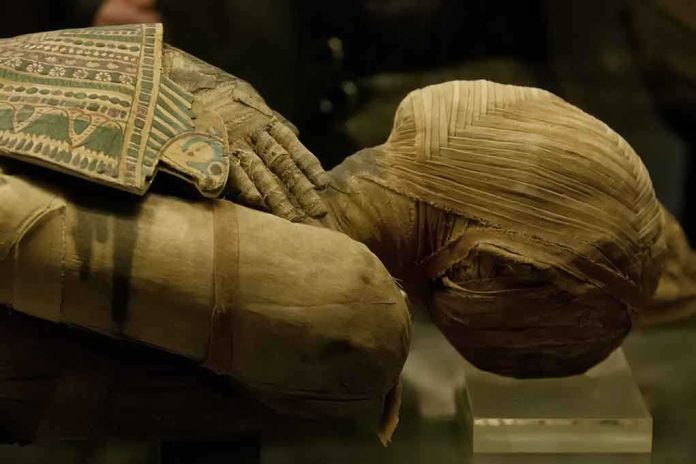
As priceless heritage succumbs to criminal neglect, the destruction of Pharaoh Amenemope’s 3,000-year-old bracelet in a government-run museum exposes vulnerabilities that threaten not just Egypt’s legacy, but the foundations of trust, security, and national pride everywhere.
Story Snapshot
- An irreplaceable 3,000-year-old bracelet from Pharaoh Amenemope was stolen and melted down for gold, erasing a vital link to ancient history.
- The theft occurred inside Egypt’s national museum, exploiting lax security and the absence of surveillance in a critical restoration lab.
- Internal staff collusion and rapid resale through local dealers enabled the artifact’s destruction before authorities could respond.
- Public outrage and official scrutiny have triggered arrests and a sweeping review of museum oversight, with global implications for artifact security.
Antiquity Destroyed: A Cautionary Tale of Security Failure
A 3,000-year-old bracelet that once adorned Pharaoh Amenemope vanished from the Egyptian Museum in Cairo on September 9, 2025, during preparations for an international exhibit. The theft was not the work of master criminals, but an inside job: a restoration specialist removed the relic from a supposedly secure laboratory and handed it to a friend in the jewelry trade. Within days, the artifact passed through a chain of dealers, sold for a fraction of its historical value, and was ultimately melted down for its gold content. This irreversible loss—unlike thefts where recovery remains possible—has sparked national outrage and renewed calls for accountability in the stewardship of world heritage.
The incident’s exposure of institutional failings is especially alarming given the museum’s status and recent history. The Egyptian Museum in Cairo houses thousands of priceless treasures, many tied intimately to the nation’s cultural and religious identity. Yet, the restoration laboratory where the bracelet was stored lacked even basic surveillance cameras, a vulnerability that criminals easily exploited. Increased activity for an upcoming Italian exhibit further reduced oversight, creating the perfect storm for disaster. Egypt’s museums have struggled with security lapses before, particularly during periods of political unrest, but the scale and brazenness of this theft have intensified scrutiny at the highest levels.
Internal Collusion and Systemic Weaknesses
Investigations quickly revealed a troubling pattern: museum insiders used privileged access to bypass safeguards, and informal networks among gold dealers facilitated the artifact’s rapid disposal. Four suspects—including the museum worker and three members of the jewelry trade—were arrested after confessing to their roles. The chain of events highlights how internal collusion, underfunded security infrastructure, and absent oversight can combine to make even national institutions vulnerable. In this case, the lack of surveillance in sensitive areas directly enabled the crime, raising questions about broader patterns of mismanagement, funding shortages, and possible corruption that undermine the very purpose of cultural protection.
While Egyptian authorities moved swiftly after the theft came to light, the damage was done. The Ministry of Tourism and Antiquities formed a special committee to inventory artifacts and review security, but their response was complicated by the incident’s initial secrecy—an attempt to avoid tipping off suspects and compromising the investigation. Public anger has only grown as details emerged. The destruction of the bracelet, confirmed by all major sources, is now a permanent loss to historians, archaeologists, and anyone who values the past as a guide for the future. The Egyptian public, whose tax money funds these institutions, rightly demands greater transparency, accountability, and safeguards against both internal and external threats.
Broader Implications: Global Heritage at Risk
The tragedy resonates far beyond Egypt’s borders. Museums worldwide face similar challenges: under-resourced security, internal collusion, and the threat of irreplaceable artifacts being lost for quick profit. Experts and heritage professionals have denounced the incident as a wake-up call, urging investment in modern surveillance, rigorous staff vetting, and robust internal controls. For Egypt, the fallout has both immediate and lasting consequences. Tourism—a vital economic engine—depends on the nation’s ability to protect its treasures. International confidence in artifact loans and exhibitions may falter, with foreign institutions demanding stricter protocols before cooperating. The loss also erodes national pride and cultural identity—an outcome that resonates with Americans who have seen government overreach and incompetence threaten the security of their own heritage and freedoms.
Egyptians outraged after priceless bracelet belonging to pharaoh stolen from museum, melted down https://t.co/Y4MeuuIiyP pic.twitter.com/g15AH8ryzx
— New York Post (@nypost) September 22, 2025
Ultimately, this case serves as a stark reminder: when institutions fail to uphold their responsibilities, the results can be catastrophic. Whether through mismanagement, lack of oversight, or misguided priorities, the loss of irreplaceable history is a loss for all. Those who cherish tradition, value accountability, and demand that governments protect—not endanger—their nation’s legacy will see in this tragedy a rallying cry for reform, vigilance, and respect for what truly matters.
Sources:
Ancient Egyptian pharaoh’s 3,000-year-old bracelet stolen, melted down for gold jewelry
Outrage in Egypt after 3,000-year-old pharaoh’s bracelet stolen, melted down
Cairo bracelet gold stolen Egypt













